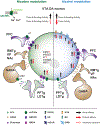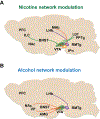Nicotine and alcohol: the role of midbrain dopaminergic neurons in drug reinforcement
- PMID: 30251377
- PMCID: PMC6431587
- DOI: 10.1111/ejn.14160
Nicotine and alcohol: the role of midbrain dopaminergic neurons in drug reinforcement
Abstract
Nicotine and alcohol addiction are leading causes of preventable death worldwide and continue to constitute a huge socio-economic burden. Both nicotine and alcohol perturb the brain's mesocorticolimbic system. Dopamine (DA) neurons projecting from the ventral tegmental area (VTA) to multiple downstream structures, including the nucleus accumbens, prefrontal cortex, and amygdala, are highly involved in the maintenance of healthy brain function. VTA DA neurons play a crucial role in associative learning and reinforcement. Nicotine and alcohol usurp these functions, promoting reinforcement of drug taking behaviors. In this review, we will first describe how nicotine and alcohol individually affect VTA DA neurons by examining how drug exposure alters the heterogeneous VTA microcircuit and network-wide projections. We will also examine how coadministration or previous exposure to nicotine or alcohol may augment the reinforcing effects of the other. Additionally, this review briefly summarizes the role of VTA DA neurons in nicotine, alcohol, and their synergistic effects in reinforcement and also addresses the remaining questions related to the circuit-function specificity of the dopaminergic system in mediating nicotine/alcohol reinforcement and comorbidity.
Keywords: alcohol; circuit; dopamine; electrophysiology; heterogeneity; nicotine; reinforcement; ventral tegmental area.
© 2018 Federation of European Neuroscience Societies and John Wiley & Sons Ltd.
Conflict of interest statement
The authors declare no conflict of interest.
Figures



Similar articles
-
Investigating the effects of chronic perinatal alcohol and combined nicotine and alcohol exposure on dopaminergic and non-dopaminergic neurons in the VTA.Sci Rep. 2021 Apr 22;11(1):8706. doi: 10.1038/s41598-021-88221-8. Sci Rep. 2021. PMID: 33888815 Free PMC article.
-
Nicotinic acetylcholine receptors in the mesolimbic pathway: primary role of ventral tegmental area alpha6beta2* receptors in mediating systemic nicotine effects on dopamine release, locomotion, and reinforcement.J Neurosci. 2010 Apr 14;30(15):5311-25. doi: 10.1523/JNEUROSCI.5095-09.2010. J Neurosci. 2010. PMID: 20392953 Free PMC article.
-
Peri-adolescent alcohol consumption increases sensitivity and dopaminergic response to nicotine during adulthood in female alcohol-preferring (P) rats: Alterations to α7 nicotinic acetylcholine receptor expression.Behav Brain Res. 2019 Dec 30;376:112190. doi: 10.1016/j.bbr.2019.112190. Epub 2019 Aug 29. Behav Brain Res. 2019. PMID: 31473285 Free PMC article.
-
Tribute to: Self-administered nicotine activates the mesolimbic dopamine system through the ventral tegmental area [William Corrigall, Kathleen Coen and Laurel Adamson, Brain Res. 653 (1994) 278-284].Brain Res. 2016 Aug 15;1645:61-4. doi: 10.1016/j.brainres.2015.12.064. Epub 2016 Feb 8. Brain Res. 2016. PMID: 26867702 Review.
-
Diversity of Dopaminergic Neural Circuits in Response to Drug Exposure.Neuropsychopharmacology. 2016 Sep;41(10):2424-46. doi: 10.1038/npp.2016.32. Epub 2016 Mar 3. Neuropsychopharmacology. 2016. PMID: 26934955 Free PMC article. Review.
Cited by
-
Restoration of MPTP-induced Dopamine and Tyrosine Hydroxylase Depletion in the Mouse Brain Through Ethanol and Nicotine.Neurotox Res. 2025 Feb 12;43(1):9. doi: 10.1007/s12640-025-00732-8. Neurotox Res. 2025. PMID: 39937382
-
Addiction in focus: molecular mechanisms, model systems, circuit maps, risk prediction and the quest for effective interventions.Eur J Neurosci. 2019 Aug;50(3):2007-2013. doi: 10.1111/ejn.14544. Eur J Neurosci. 2019. PMID: 31502353 Free PMC article. No abstract available.
-
The nucleus accumbens in reward and aversion processing: insights and implications.Front Behav Neurosci. 2024 Aug 9;18:1420028. doi: 10.3389/fnbeh.2024.1420028. eCollection 2024. Front Behav Neurosci. 2024. PMID: 39184934 Free PMC article. Review.
-
Smoking-Related Increases in Alcohol Outcomes and Preliminary Evidence for the Protective Effect of a Functional Nicotine Receptor Gene (CHRNA5) Variant on Alcohol Consumption in Individuals Without Alcohol Use Disorder.Int J Neuropsychopharmacol. 2024 Oct 1;27(10):pyae035. doi: 10.1093/ijnp/pyae035. Int J Neuropsychopharmacol. 2024. PMID: 39208422 Free PMC article.
-
Roles of dopamine and glutamate co-release in the nucleus accumbens in mediating the actions of drugs of abuse.FEBS J. 2021 Mar;288(5):1462-1474. doi: 10.1111/febs.15496. Epub 2020 Aug 11. FEBS J. 2021. PMID: 32702182 Free PMC article. Review.
References
-
- Ables JL, Görlich A, Antolin-Fontes B, Wang C, Lipford SM, Riad MH, Ren J, Hu F, Luo M, Kenny PJ, Heintz N, & Ibañez-Tallon I (2017) Retrograde inhibition by a specific subset of interpeduncular α5 nicotinic neurons regulates nicotine preference. Proc. Natl. Acad. Sci, 114, 13012–13017. - PMC - PubMed
-
- Adermark L, Söderpalm B, & Burkhardt JM (2014) Brain region specific modulation of ethanol-induced depression of GABAergic neurons in the brain reward system by the nicotine receptor antagonist mecamylamine. Alcohol, 48, 455–461. - PubMed
Publication types
MeSH terms
Substances
Grants and funding
LinkOut - more resources
Full Text Sources
Other Literature Sources
Medical

